I have very dear friends who live in Uppsala, Sweden, and who come to Belgrade occasionally. Every time when they are here I would like to go with them and visit something in our country, since all three of us like it, but so far we have never managed to fit our obligations. And then finally a suitable day in the middle of November appeared, it was supposed to be partially cloudy with sunny spells, but it turned out that the clouds and the mist were stronger, however, at least it did not rain. That’s as far as the weather was concerned. On the other hand, around the middle of November the days are rather short (it starts getting darker already around 4 pm), so this threatened to spoil things, but eventually all went well. That’s as far as the time was concerned.
Here is the map that shows the route we followed, while the entire day’s drive was around 220 km long.
First we headed south of Belgrade along the motorway and we got off at the exit to Smederevska Palanka. The first destination was village Selevac through which passes the road we were on, but here one needs to go into the village in order to get to the church. However, since this was all happening in November and November is the traditional month for slaughtering pigs and doing all other meat preparations for the winter, while in the village we passed by a very picturesque sight.
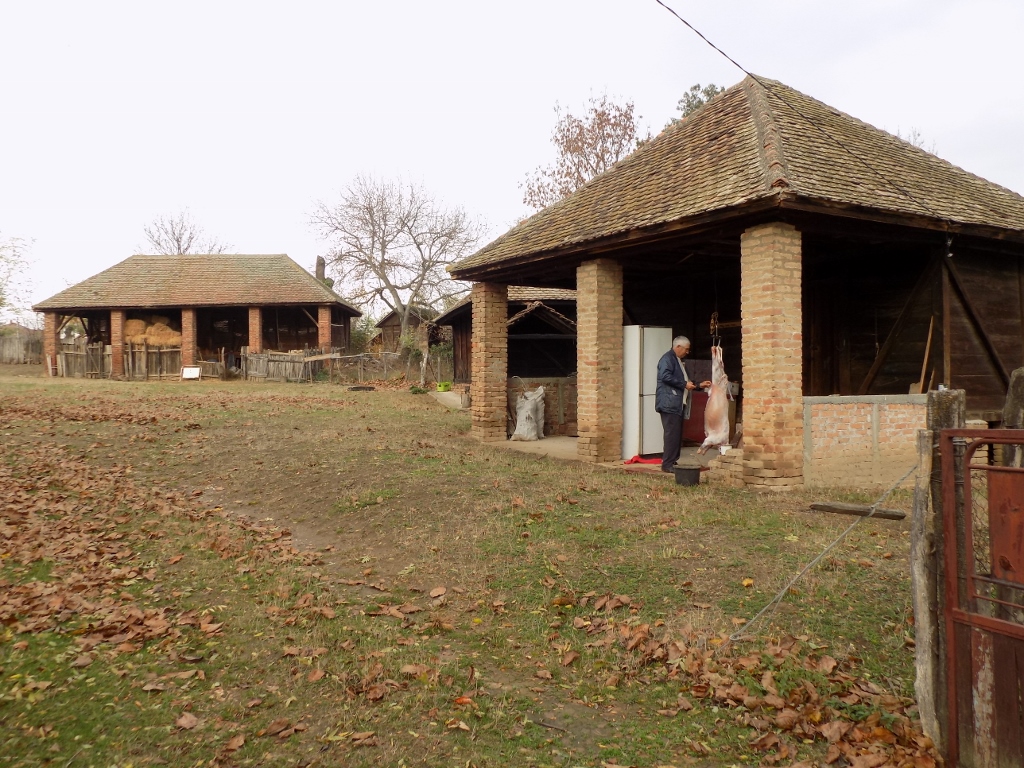 A yard in which meat is being prepared for the winter
A yard in which meat is being prepared for the winter
We parked the car by the churchyard, but before starting with the visit to the church I noticed something very interesting that was going on at the facade of a building located on the opposite side of the street. On the right-hand side of my photo there is a damaged relief inscription which says that this is the Priest’s House, the year is unclear, while on the left-hand side, although it was painted over at some point, one can see a pale remnant of inscription “Party of Yugosla...,” which almost certainly stems from the “Communist Party of Yugoslavia.” There, our history in a few words on the facade of a building in Selevac.
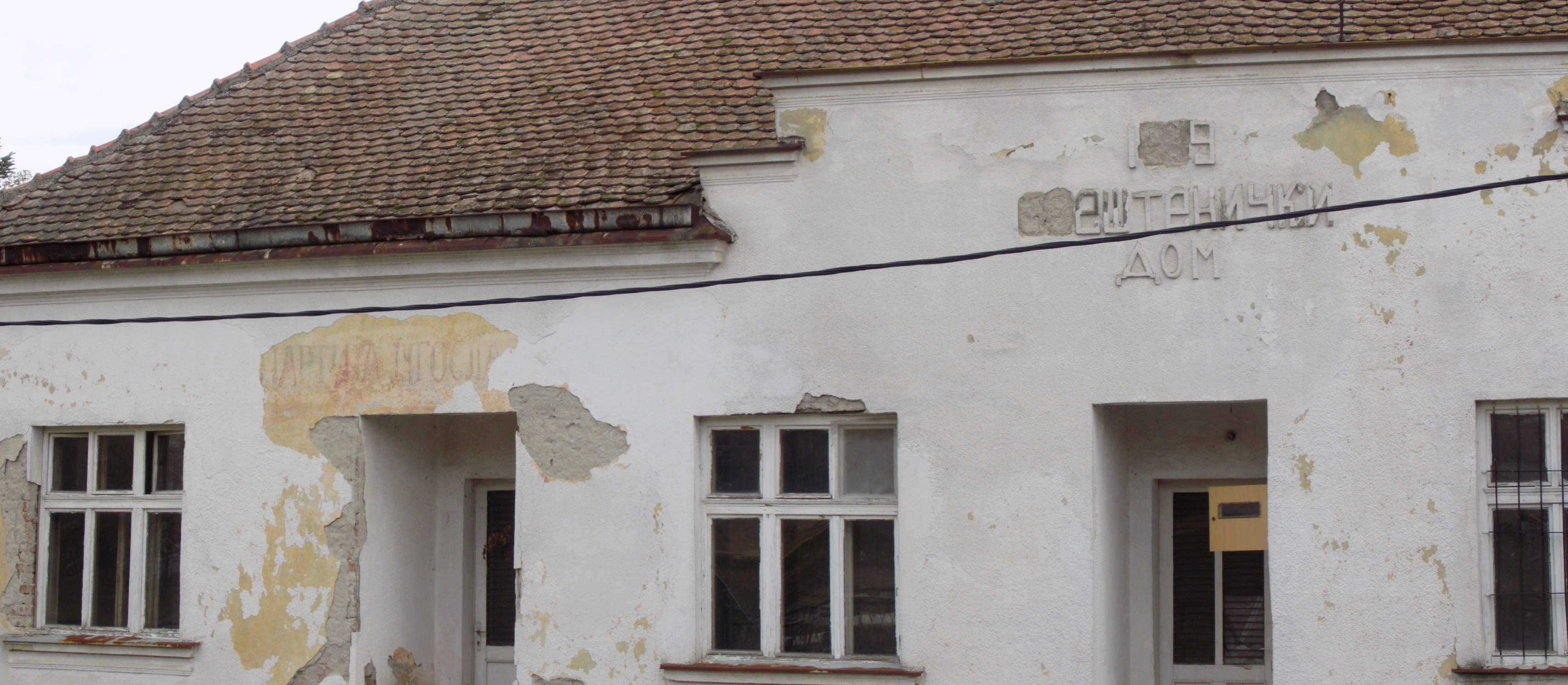
Still, the main reason for coming to Selevac was a visit to the Church of the Holy Trinity dedicated to the feast of the Descent of the Holy Spirit that was built between 1827 and 1832, in other words during the reign of Prince Miloš Obrenović and it was precisely his favourite painter, Janja Moler, who did the iconostasis partition. Today, the Church of the Holy Trinity is the cultural monument of great importance (this is part of the categorisation of cultural monuments in Serbia and I will always put it as a reference when I mention different monuments and sites).
This is a wooden church and until recently I did not even know that such churches existed in my country, so I was particularly keen on visiting this one.
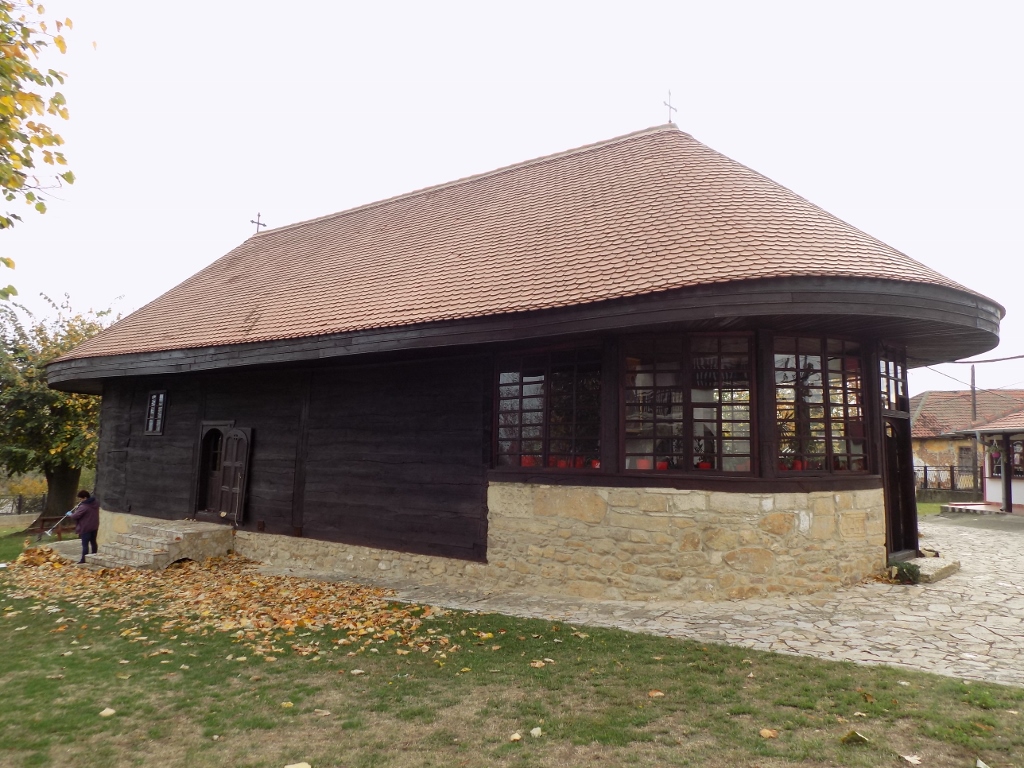 Church of the Holy Trinity in Selevac
Church of the Holy Trinity in Selevac
Originally, it used to have a naos and a narthex, but over time this was brought together into single space after which a porch with a stone-built fence was added and thus it became the biggest wooden church in Serbia (including this subsequently added porch). As I’ve read, under the present-day roof made of beaver-tail tiles, there is still a wood-shingles roof, but it can no longer be seen.
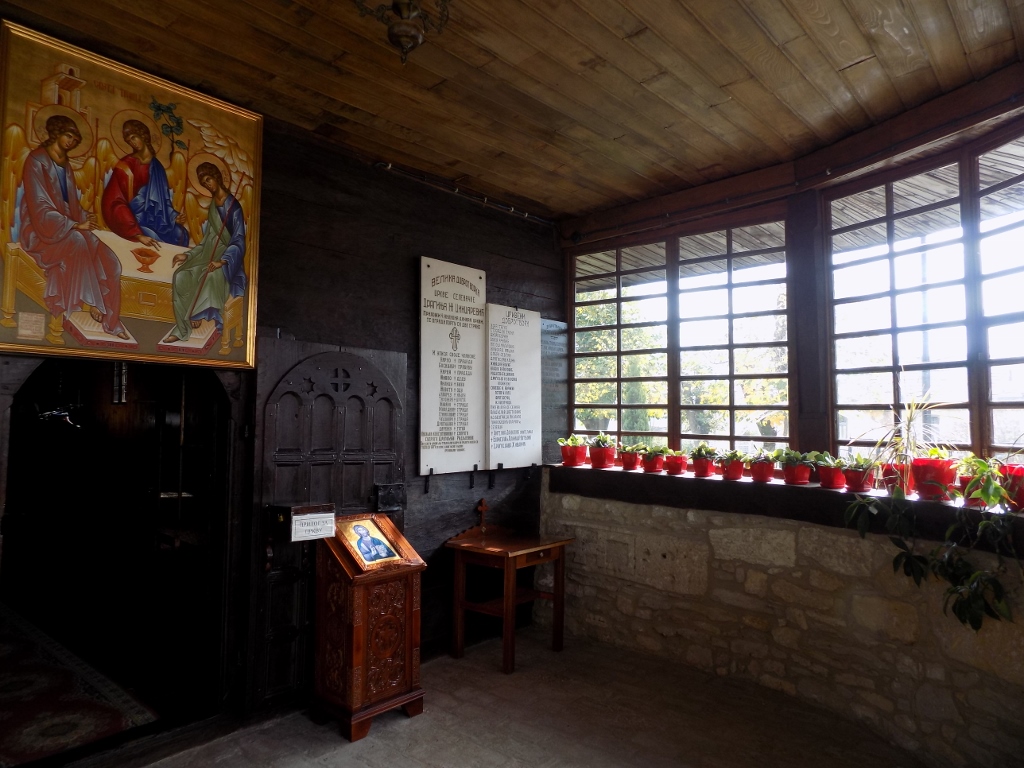 Church of the Holy Trinity, the porch
Church of the Holy Trinity, the porch
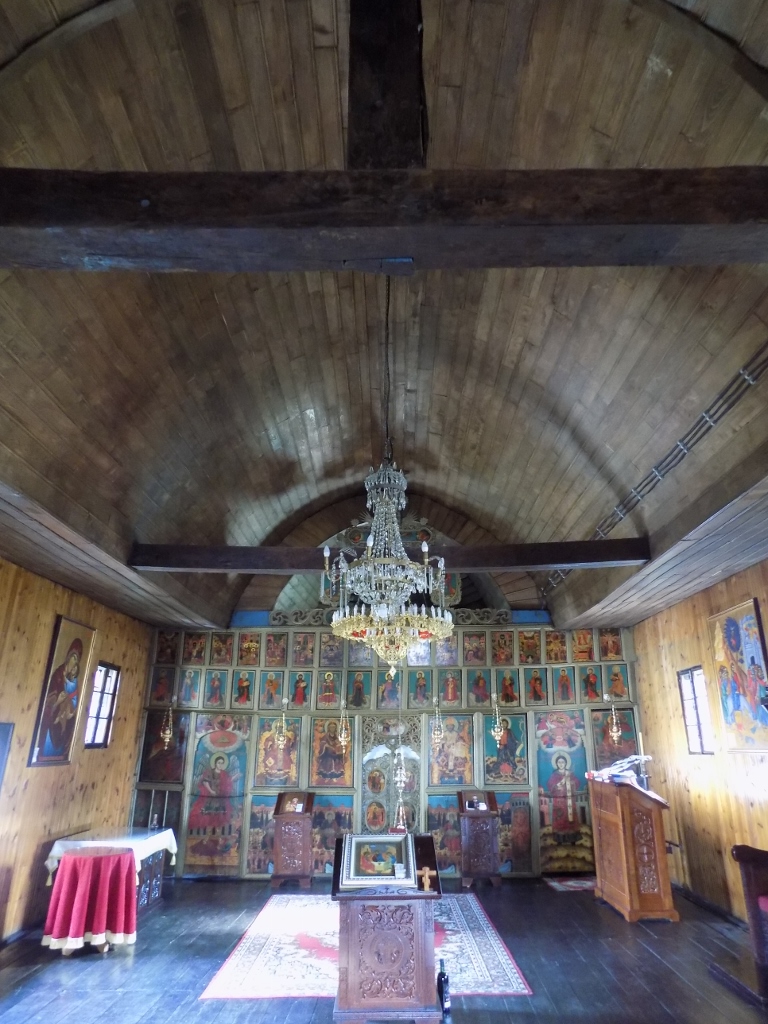 Church of the Holy Trinity, the naos
Church of the Holy Trinity, the naos
When you enter the church, your view naturally flows towards the iconostasis the icons of which were painted in 1834. Because of the manner and the style in which these icons were painted, this iconostasis ensemble is considered to be the most representative one found in wooden churches (in Serbia).
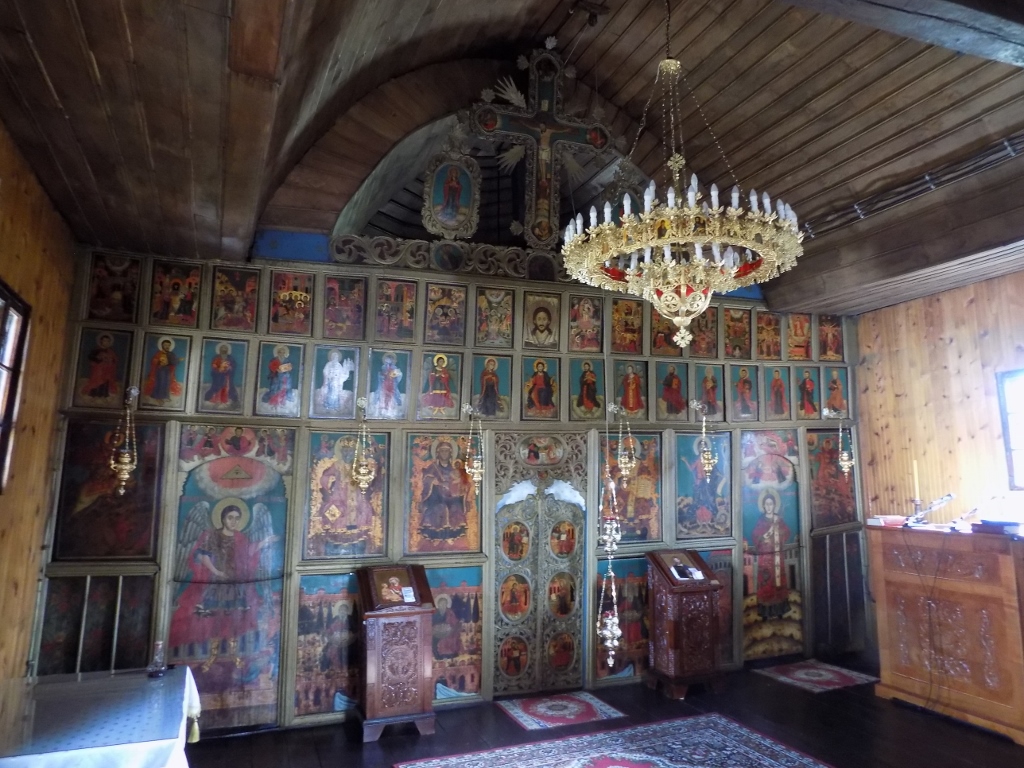 Church of the Holy Trinity, the iconostasis
Church of the Holy Trinity, the iconostasis
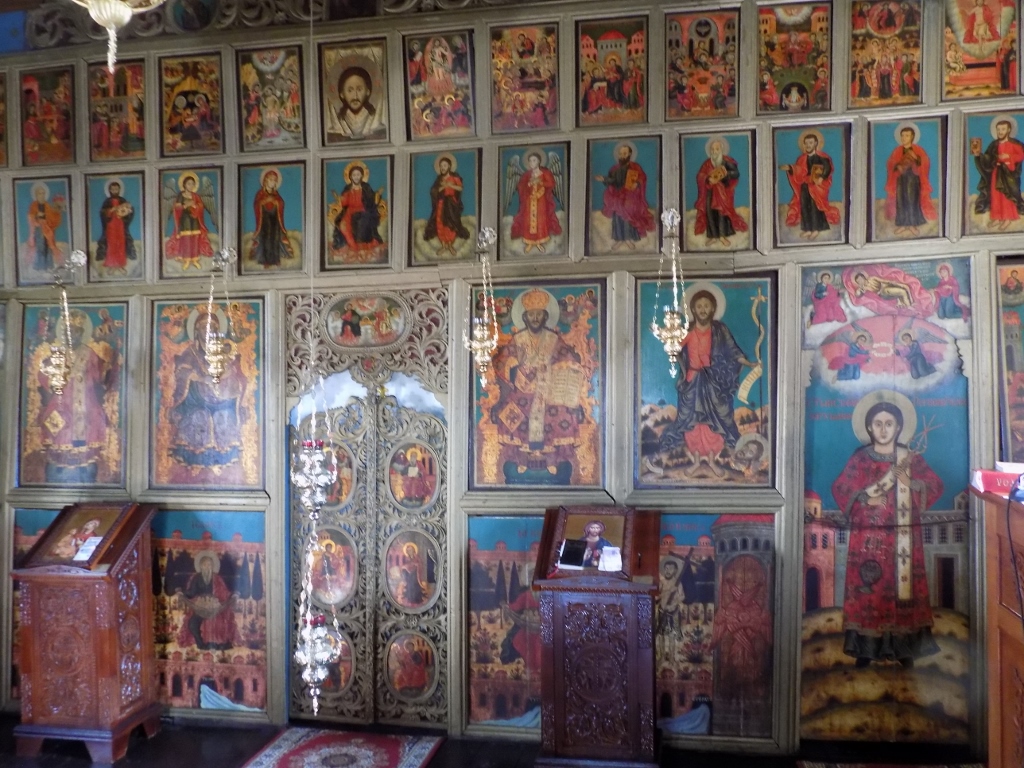 Church of the Holy Trinity, the iconostasis
Church of the Holy Trinity, the iconostasis
Although this may not seem very important to laymen such as me, the data on this church emphasize nonetheless that on the east side it ends in a polygonal apse. This may be seen quite well when you go around the church from the outside and then it is also interesting to see the manner in which it was built.
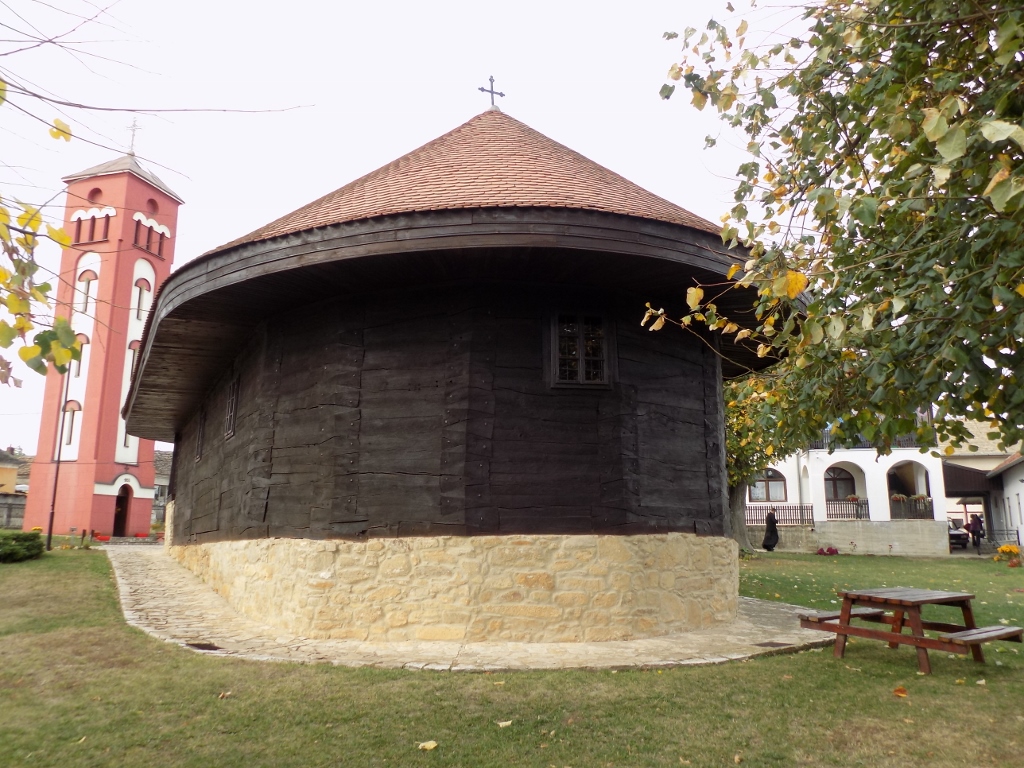 Church of the Holy Trinity, the altar apse from the outside
Church of the Holy Trinity, the altar apse from the outside
After this we continued in the direction of Mladenovac. The road took us by a village cemetery and there we stopped since we noticed some big sepulchres and we wanted to have a better look at them.
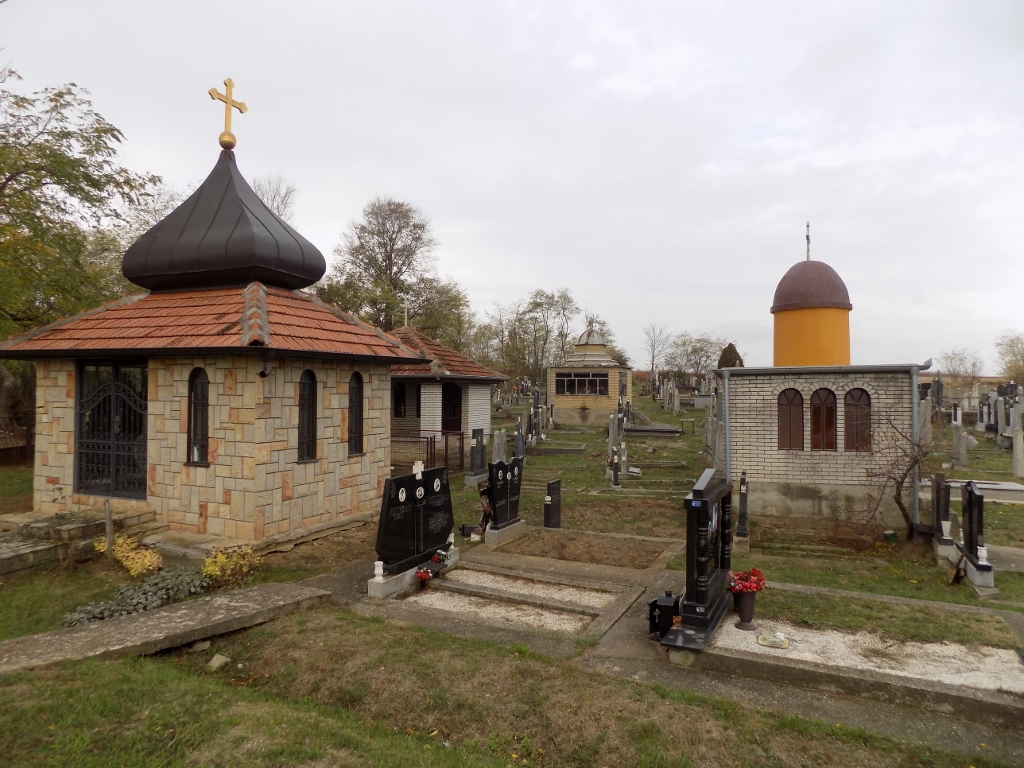 Local cemetery
Local cemetery
I must admit that when I see sepulchres such as these, together with tables and sitting benches inside them, I can hear a voice of a part of me as well as frequent comments of “modern” and “intellectual” types who spit at customs like this, including also the frequent traditional eating at graveyards. Luckily, this part of mine that voices itself negatively in situations like this gets quieted down by the bigger part of me which is significantly more open for the differences in this world.
When on this day I read the inscriptions on some of these tombs found in the local cemetery, the deeply tragic destiny of some of these deceased people became quite clear to me and I thought that even building a high-rise at the place of the interment could certainly not bring anybody back, but I also realised that if the building of such sepulchres made sense to those who outlived them and if it brought them some peace, WHO WAS I TO JUDGE anything here?
The next destination of our excursion was a monastery on the slopes of mount Kosmaj. In order to get there, one needs to drive through Mladenovac and then follow Kosmajski put (Kosmaj road) for some 8 km. At some point there is a sign showing that one needs to turn left at that point. At the time we were there, some workers were laying down a gas pipeline, so there was a lot of earthwork going on, but we could still pass by car. The workers also told us that the monk who lived at the monastery was not there at the time, since he went to visit a family that had their Slava (family’s saint’s day feast) on that day.
We did not mind any of that in order to visit Pavlovac monastery, i.e., in order to see the church that belongs to the monastery. This is a cultural monument of great importance and its ktetor was Despot Stefan Lazarević.
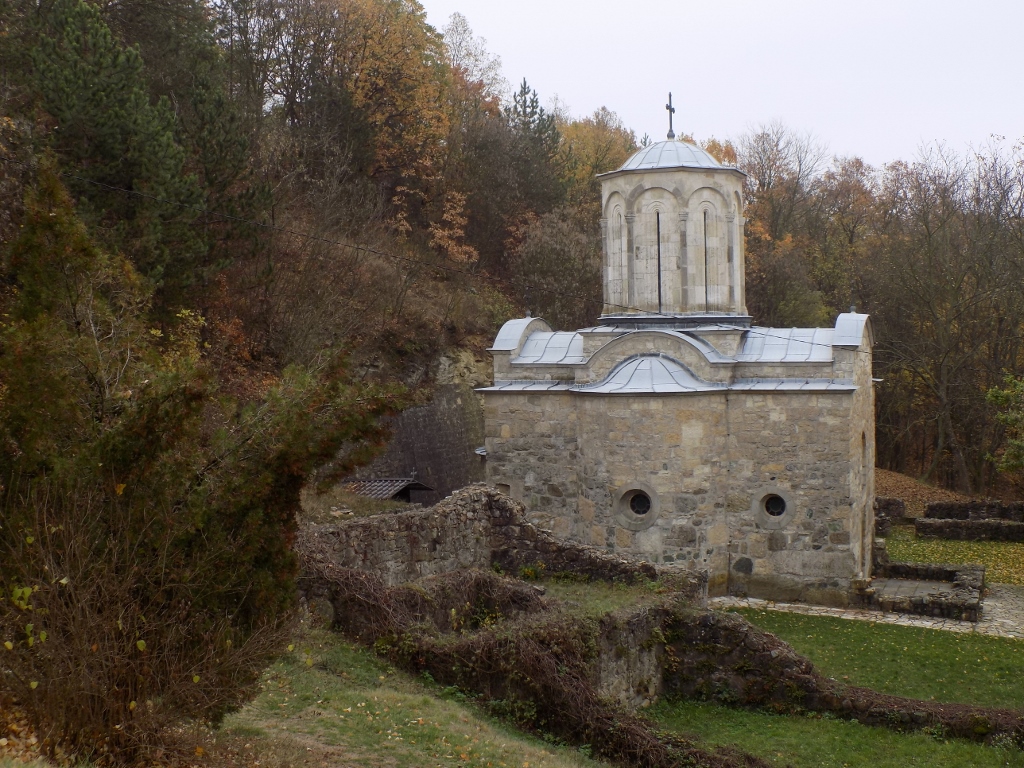 Pavlovac monastery
Pavlovac monastery
The monastery was built in 1425, then it was demolished and remained like that for a long period of time, only to be renewed in the second half of the 16th century. In 1690, after the Great Migrations of the Serbs under the leadership of Patriarch Arsenije Čarnojević, the Ottomans killed the monks who remained here and destroyed the monastery. The monastery was renewed again in 1967. On both sides of the church there are remains of the edifices that are thought to have served as the monastery’s dormitory and as the summer residence of Despot Stefan Lazarević. The church is dedicated to Saint Nicholas.
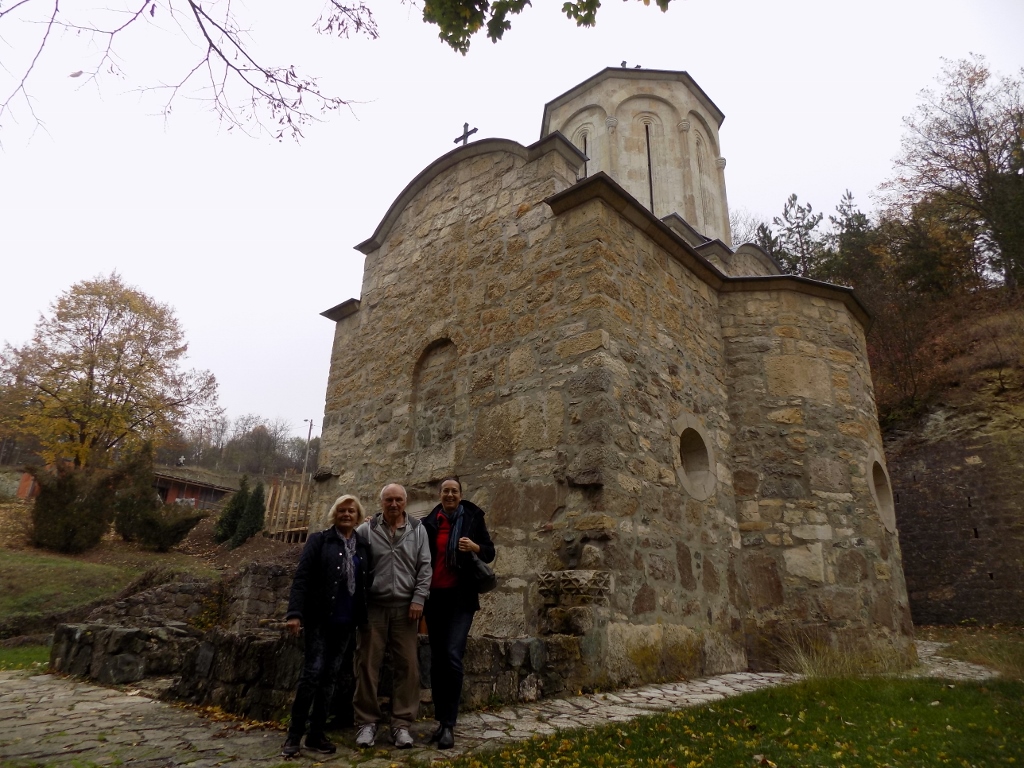 With my friends at Pavlovac Monastery
With my friends at Pavlovac Monastery
In addition to the gas pipeline I have mentioned, a large dormitory is also being built at the elevation near the church.
During the continuation of our journey, I had to make a stop at some point and take photo of the autumnal treetops that seemed as if somebody had scattered gold leaves on their tops. I wonder what it must have looked like when there was sunshine.
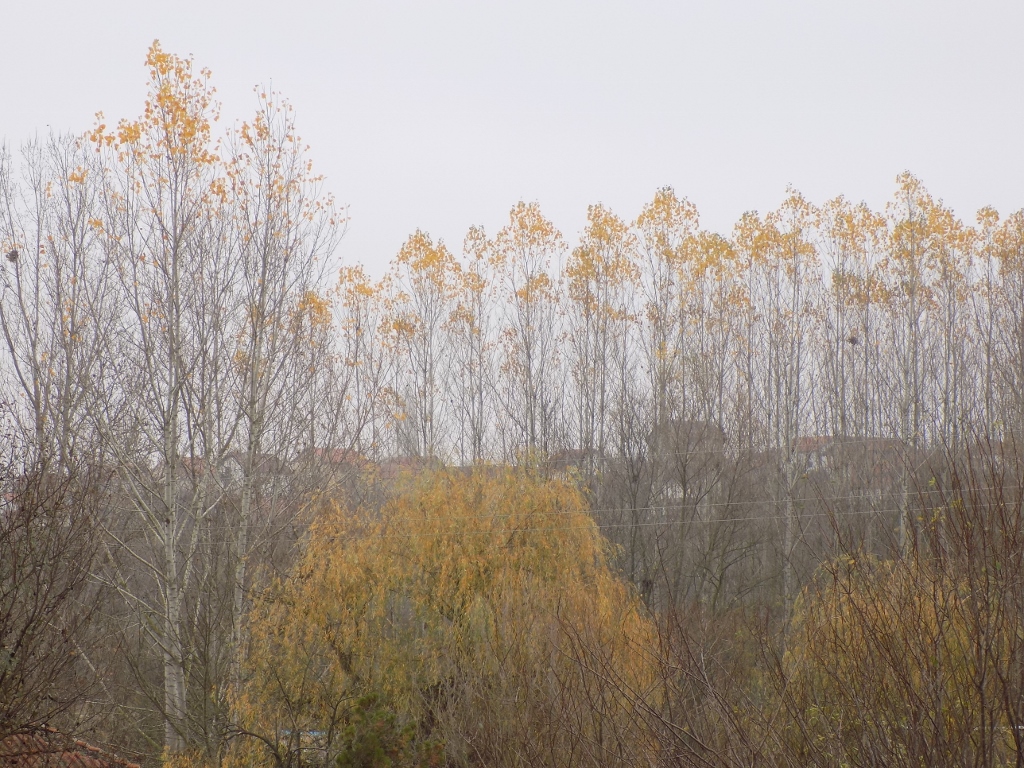 Golden tops of the autumnal treetops
Golden tops of the autumnal treetops
The main reason why I wanted to go to Pavlovac Monastery in the first place was the fact that it was one of the pious endowments of Despot Stefan Lazarević. (By the way, his most famous endowment is the extraordinarily beautiful Manasija Monastery.)
Namely, the next point on our tour was the hamlet of Crkvine, or more accurately the yard of the Church of the Holy Prophet Elijah, or more accurately a marble monument, a cenotaph, dedicated precisely to Despot Stefan Lazarević and erected here in 1427 marking the place in which the despot died on 19 July of the same year. Despot Stefan Lazarević is a very important historic figure from medieval Serbia, son of Prince Lazar and Princess Milica, he was renowned for being one of the best knights and military leaders of his time, as well as one of the greatest medieval Serbian writers – his is Slovo ljubve, a Homage to Love. As the customs of the age ordered, the despot was keen on hunting and the slopes of mount Kosmaj were one of his favourite places. So it happened that he felt weakness in this spot, some say it was a heart attack, others that it was a stroke, but be as it may he took his last breath here while being 49 or 50 years of age.
When we reached Crkvine, we came across three experts from the Republic Institute for the Protection of Cultural Monuments from Belgrade who were working on the restoration and conservation of the monument.
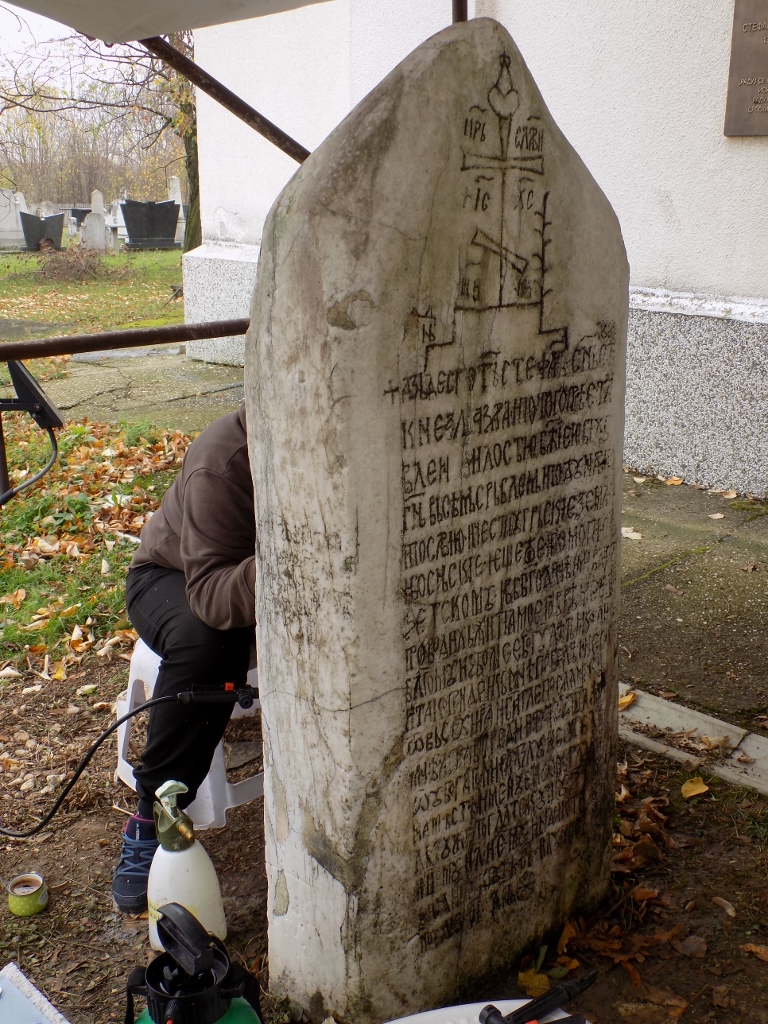 Monument to Despot Stefan Lazarević: ongoing restoration
Monument to Despot Stefan Lazarević: ongoing restoration
This is a unique example of the monument of this kind in the Balkans and at the same time it is the oldest public monument on the territory of Belgrade. It is also a cultural monument of exceptional importance for the Serbian heritage.
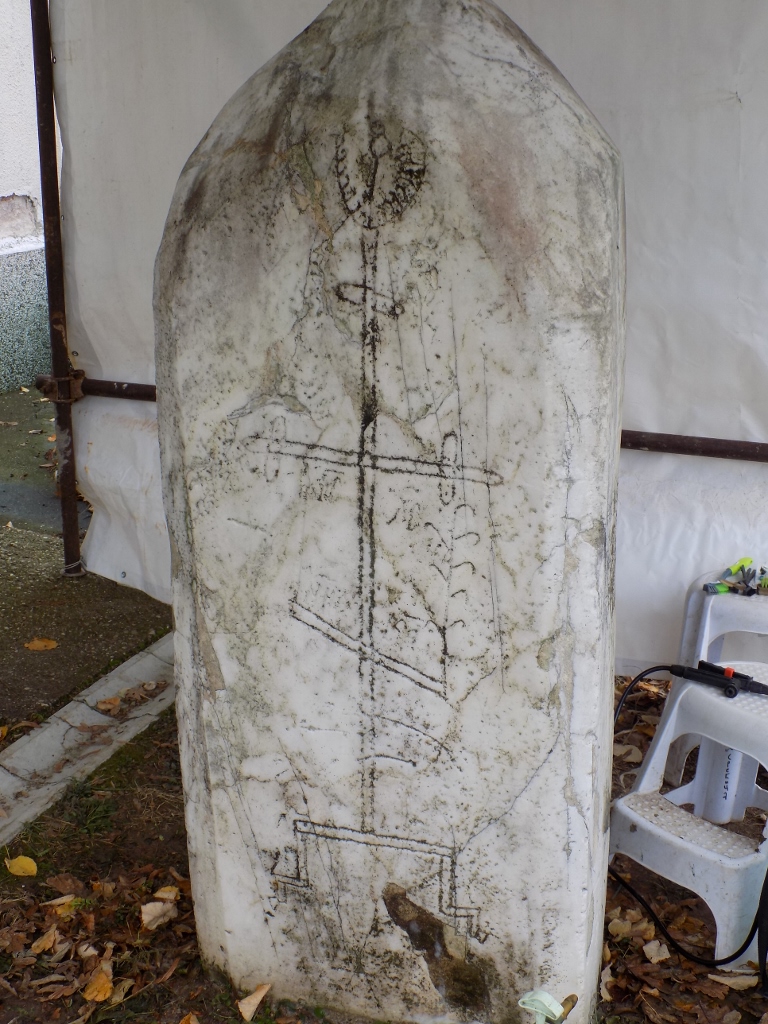 Monument to Despot Stefan Lazarević, the other side of the cenotaph
Monument to Despot Stefan Lazarević, the other side of the cenotaph
The cenotaph is almost 2 metres tall and it is located right next to a side wall of the church.
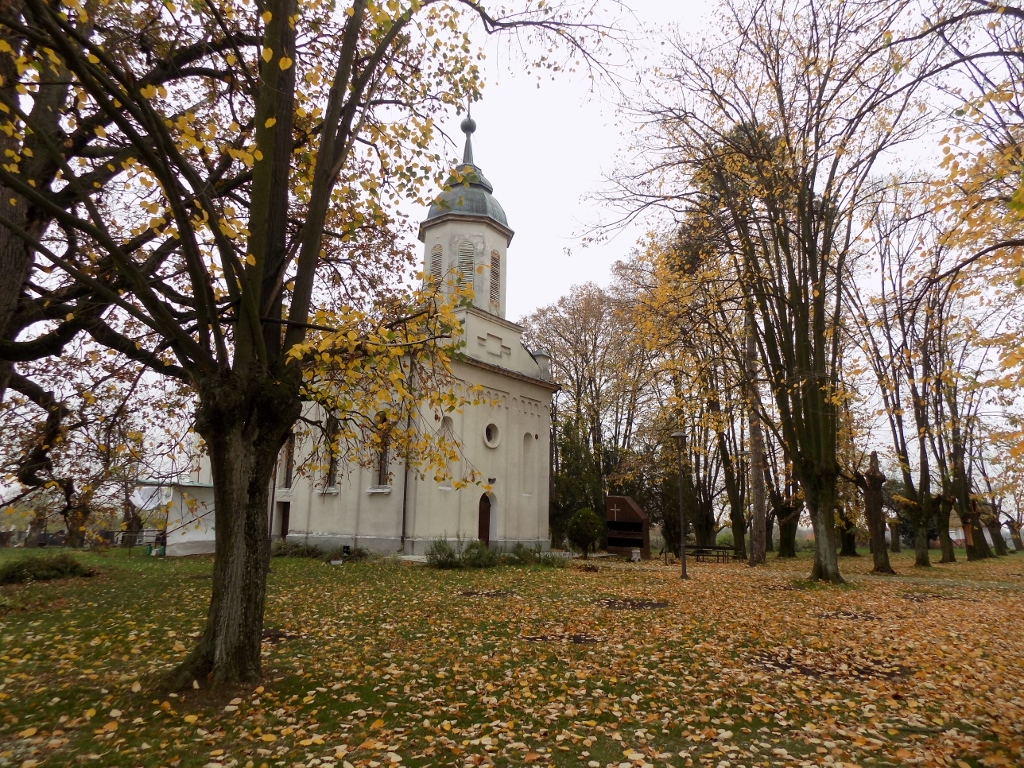 Church of the Holy Prophet Elijah in Crkvine, to the left behind the tree there is a canopy under which is the cenotaph
Church of the Holy Prophet Elijah in Crkvine, to the left behind the tree there is a canopy under which is the cenotaph
As far as the church is concerned, it was built in 1886 in the place of an older church which is presumed to have been built by Despot Stefan Lazarević and which was destroyed in an earthquake in 1884. The priest was not here this day, but one of the very kind experts from the Institute who had the keys took us into the church and there we chatted nicely a little bit more.
On the road to Crkvine hamlet and certainly also when we were driving back to the main road, we passed by Markovačko lake and we made a brief stop there. I found the instructions on a board displayed by the lake particularly cute since it expressly stated that “every caught carp must be immediately returned undamaged back to the water regardless of its size.” On this day, there were no fishermen and we also did not see anybody in the restaurant on the shore, but this seemed to me to be a good place to stop by when the weather is nice, warm and sunny. Whether you fish or not.
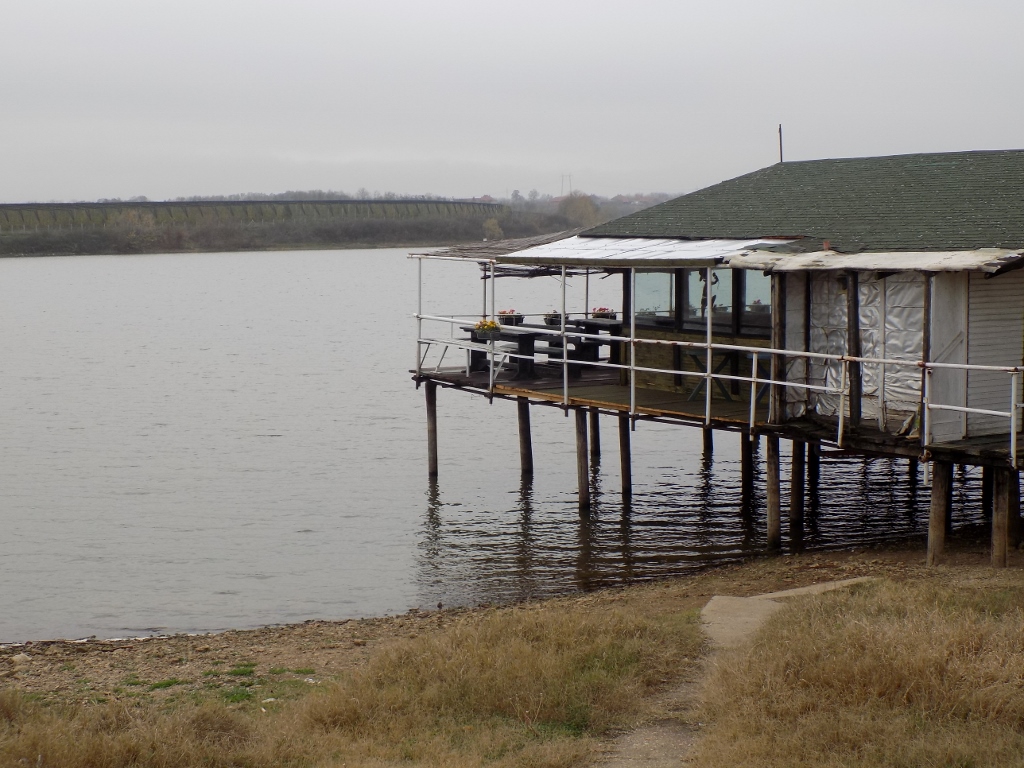 Markovačko lake
Markovačko lake
After this, we continued along the main road in the direction of Aranđelovac and thus we came to Orašac. There we parked the car and walked to Marićević’s Gully, which is a cultural monument of exceptional importance. This is the place where according to the accounts a group of distinguished Serbs gathered in 1804 and agreed to start an uprising against the Ottomans, which will be recorded in the history as the First Serbian Uprising, and on this occasion they chose Đorđe Petrović Karađorđe as their leader. It is precisely the date of this event, 15 February, that is marked in Serbia as the Statehood Day.
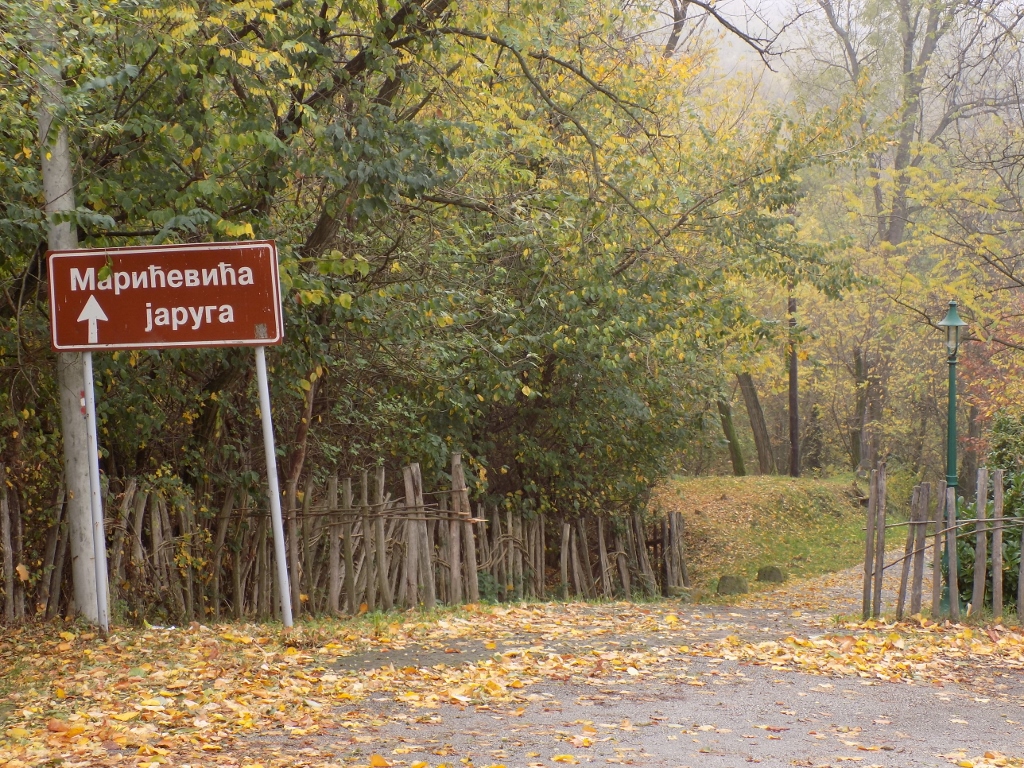 Path leading to Marićević’s Gully
Path leading to Marićević’s Gully
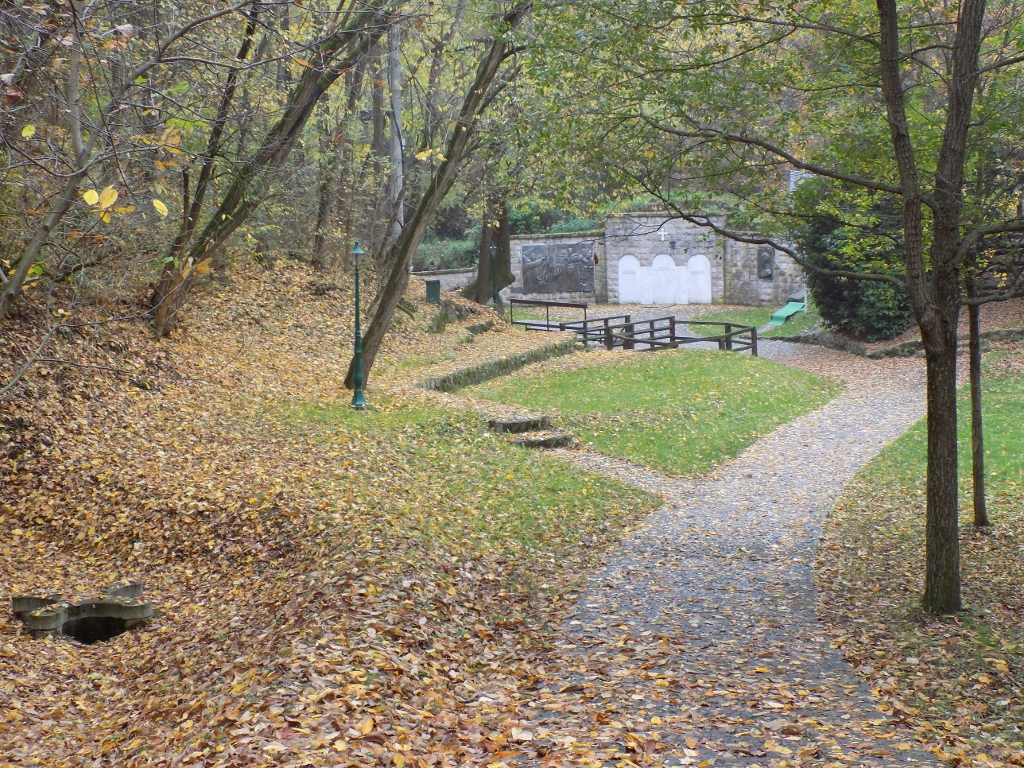 Marićević’s Gully
Marićević’s Gully
After the return from the walk to the gully, we first went to the Church of the Ascension of our Lord that belongs to the complex celebrating the First Serbian Uprising and that was built between 1868 and 1870. The icons for the iconostasis at the church were painted by Stevan Todorović, one of the most distinguished Serbian painters of the second half of the 19th century, the same one who did the icons for the church in Idvor (https://www.svudapodji.com/en/idvor/).
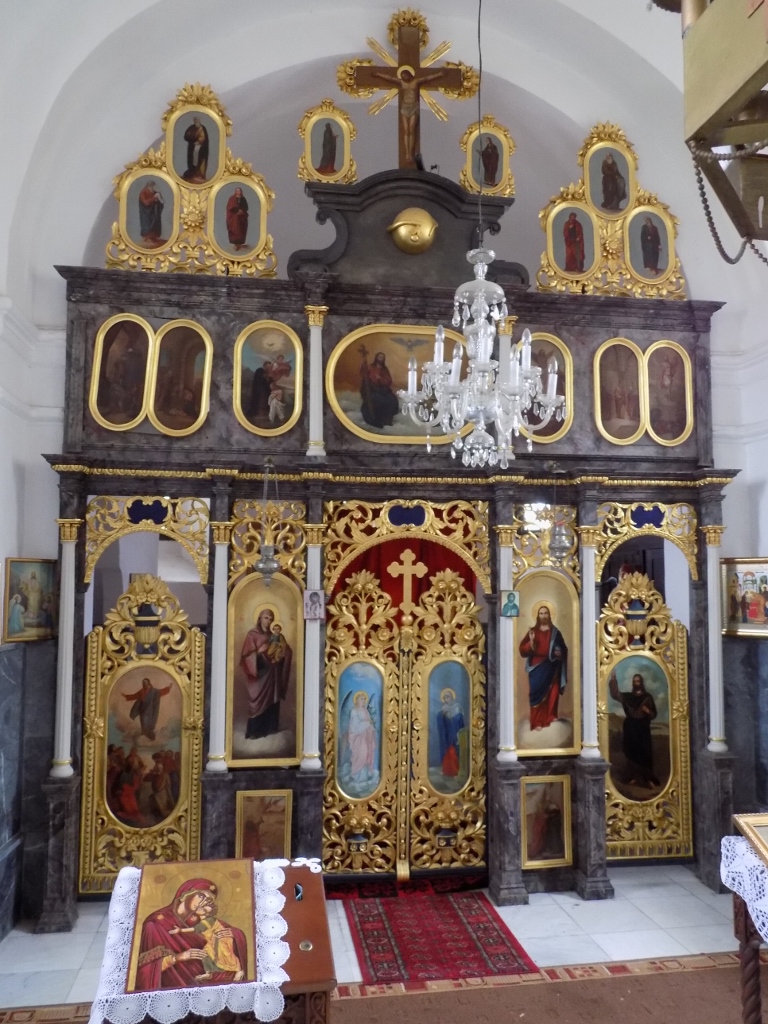 Iconostasis at the Church of the Ascension of our Lord
Iconostasis at the Church of the Ascension of our Lord
We eventually completed our visit to Orašac with a visit to a small, but very nice museum where visitors can go into more details related to the events around the First Serbian Uprising that marked the beginning of the final liberation of Serbia after several centuries spent under the Ottoman rule.
Orašac is located on the territory of Aranđelovac municipality and although the town itself, as well as its surroundings hold numerous other interesting places to be visited on this day my plan did not include those, but rather we continued along a nice and winding road towards Lazarevac, another small town. Originally I planned to have a nice lunch there, but my plan had a serious flaw – it was November, the days were short and we did not leave very early in the morning. So, along the way I realized we could not sit down in a restaurant and have proper lunch and visit all that I wanted. In situations such as this one, I actually do not have any dilemma. I am always ready to improvise with my food in order to see and visit as many interesting places as possible. Still, I was not alone here. However, it turned out that my friends also share my interests and they are also flexible as far as food is concerned, so in Lazarevac we had a very nice and big pljeskavica (Serbian traditional hamburger) and continued with our sightseeing.
The new destination on our tour was yet another church, the Church of St Demetrios in the centre of the town, but this one is linked to WWI or more accurately to the Battle of the Kolubara.
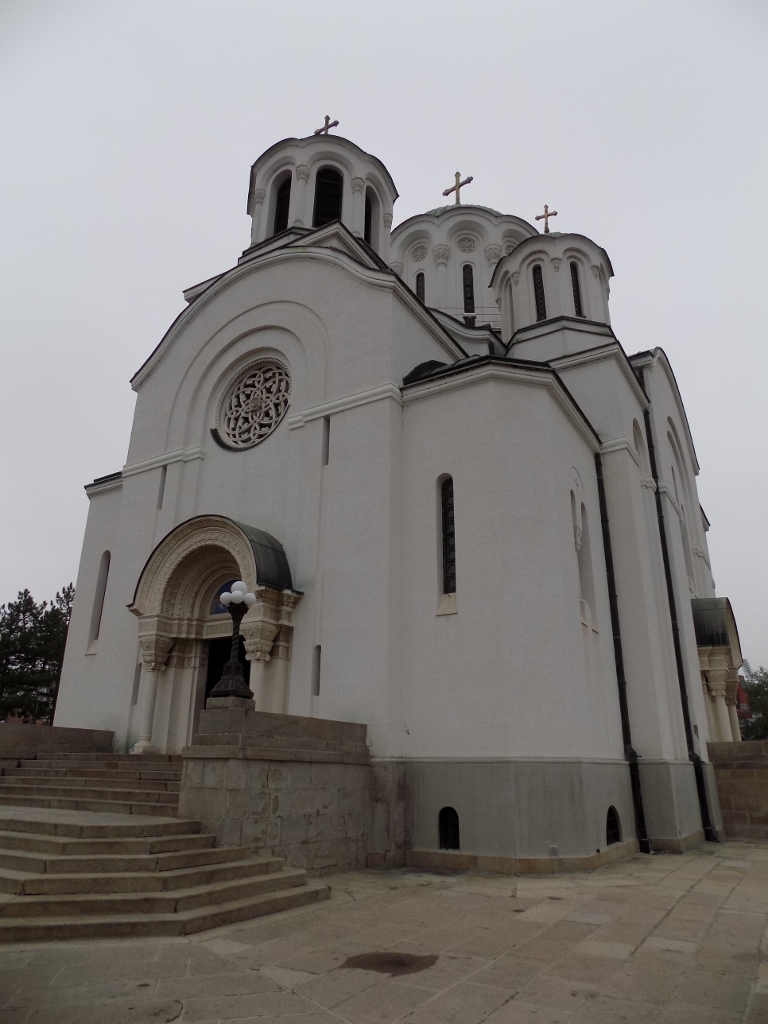 Church of St Demetrios
Church of St Demetrios
The Battle of the Kolubara was fought from 16 November to 15 December, 1914 and this is one of the greatest and most glorious battles won by the Serbian Army in WWI. With this battle the Austro-Hungarian forces were expelled from the territory of Serbia, but this also had a very high price in the number of those killed. It is precisely the mortal remains of around 20,000 Serbian soldiers killed in the Battle of the Kolubara that were laid to rest in the ossuary situated under the church in Lazarevac that we visited. The construction of the ossuary and the church started in 1938, but there were significant damages to it during WWII. Everything was finally restored in 1961.
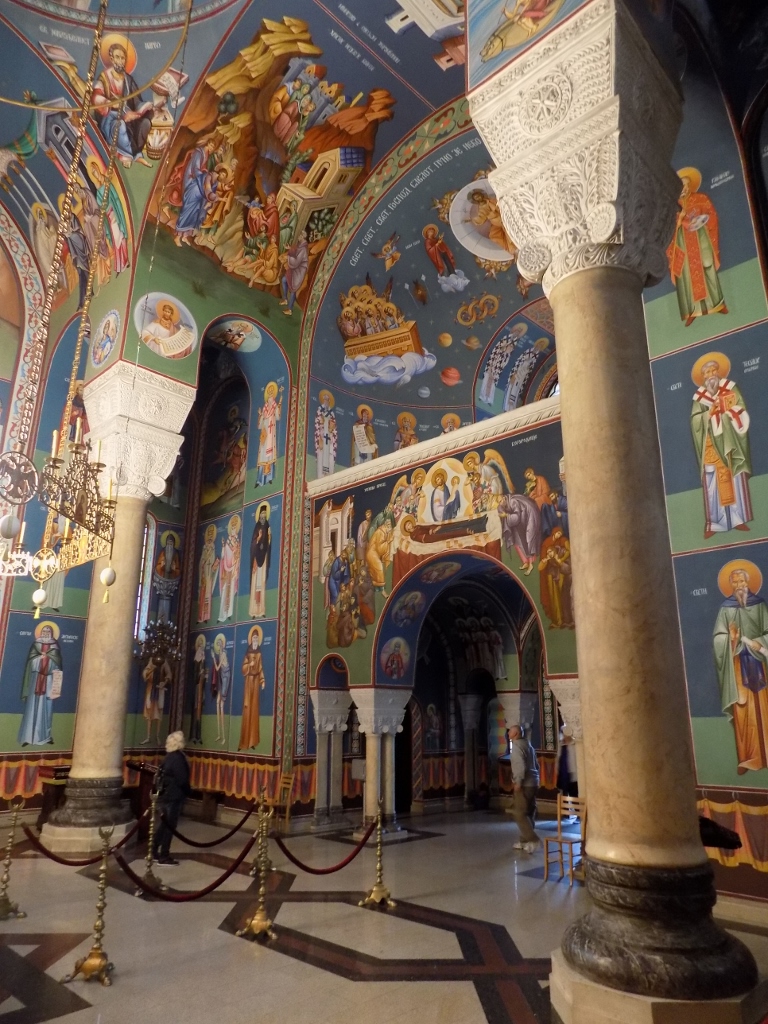 Church of St Demetrios, the interior
Church of St Demetrios, the interior
When you enter the church, after those medieval frescoes of dimmed colours that I am somehow used to, these here appear very unusual with their fresh and lively colours. On the other hand, I cannot say that I did not like them. It was just somewhat different from what my eyes are used to.
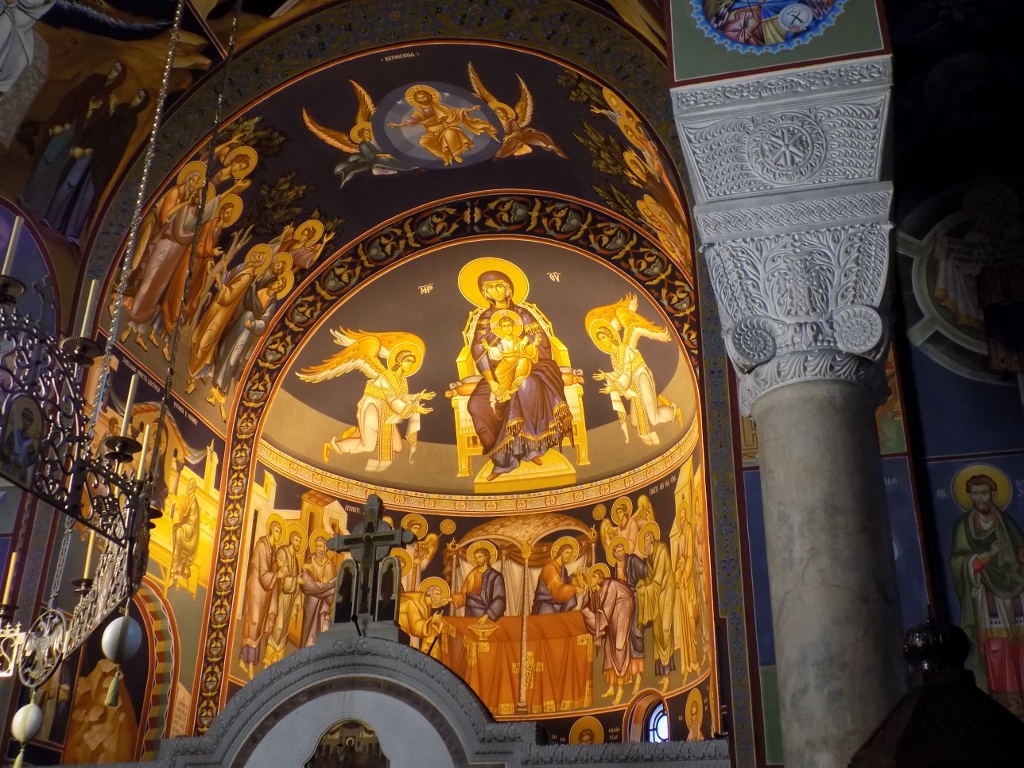 Church of St Demetrios, the interior
Church of St Demetrios, the interior
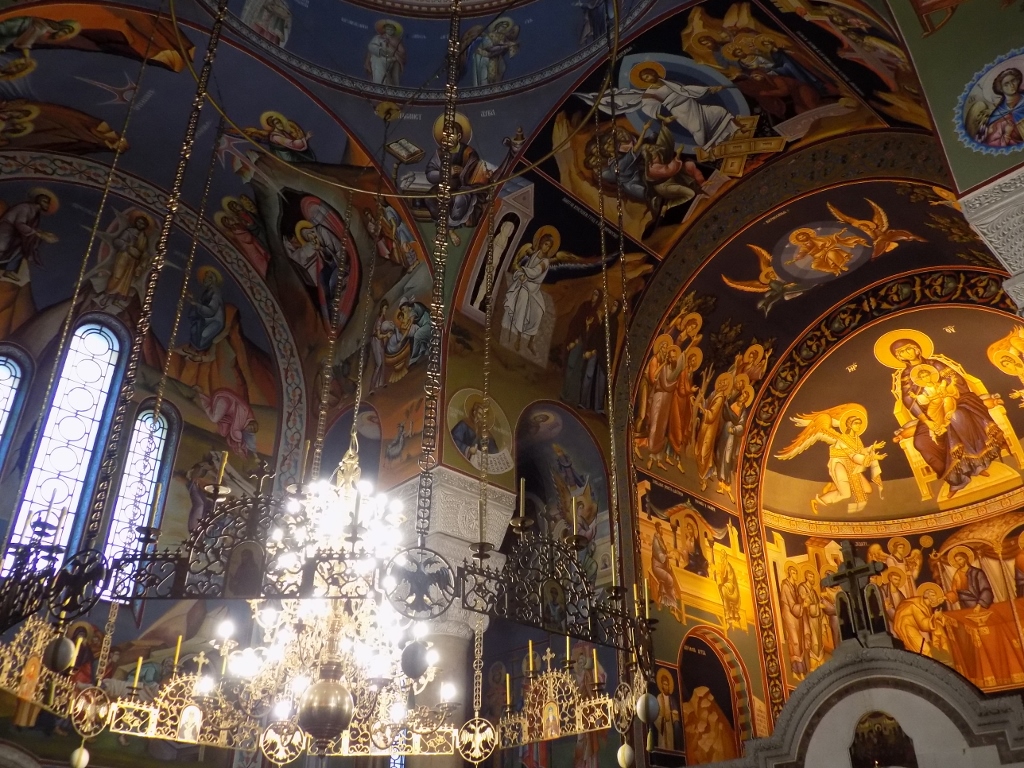 Church of St Demetrios, the interior
Church of St Demetrios, the interior
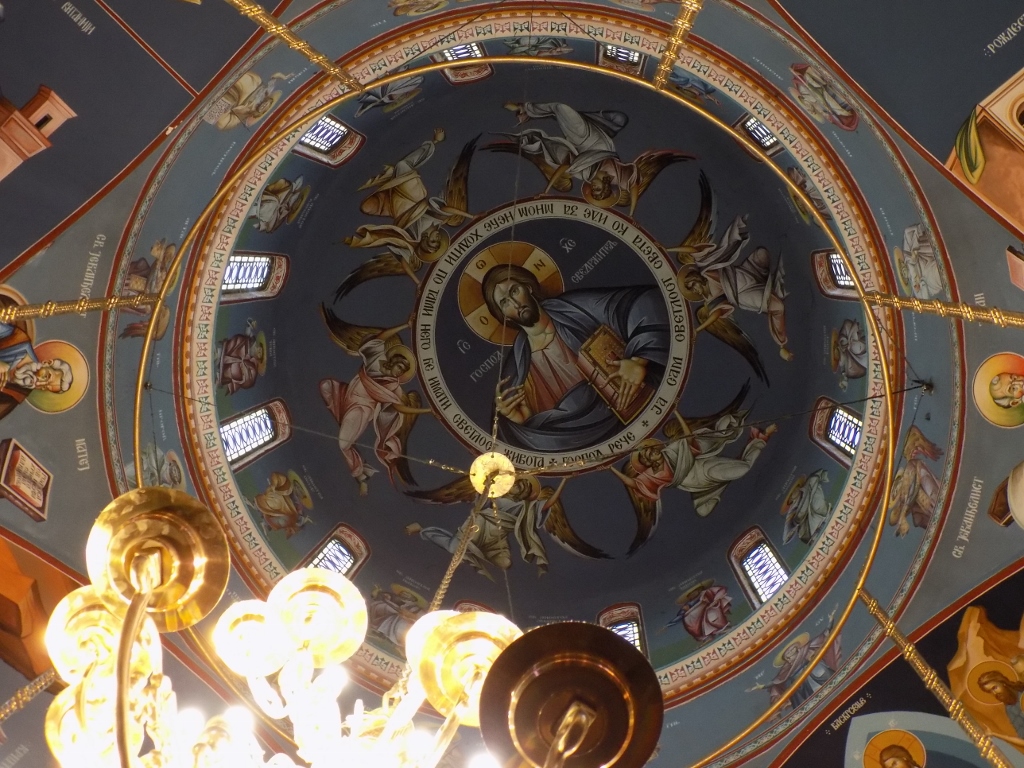 Church of St Demetrios, the interior
Church of St Demetrios, the interior
Still, I was a little confused since the main reason for our coming here was the crypt and while we were walking around the church the man who worked at the church went out for a little while and we did not know when exactly he would be back and how we can visit what we wanted. Luckily, a woman came who was probably replacing him and then she turned on the lights for us to be able to go down into the crypt.
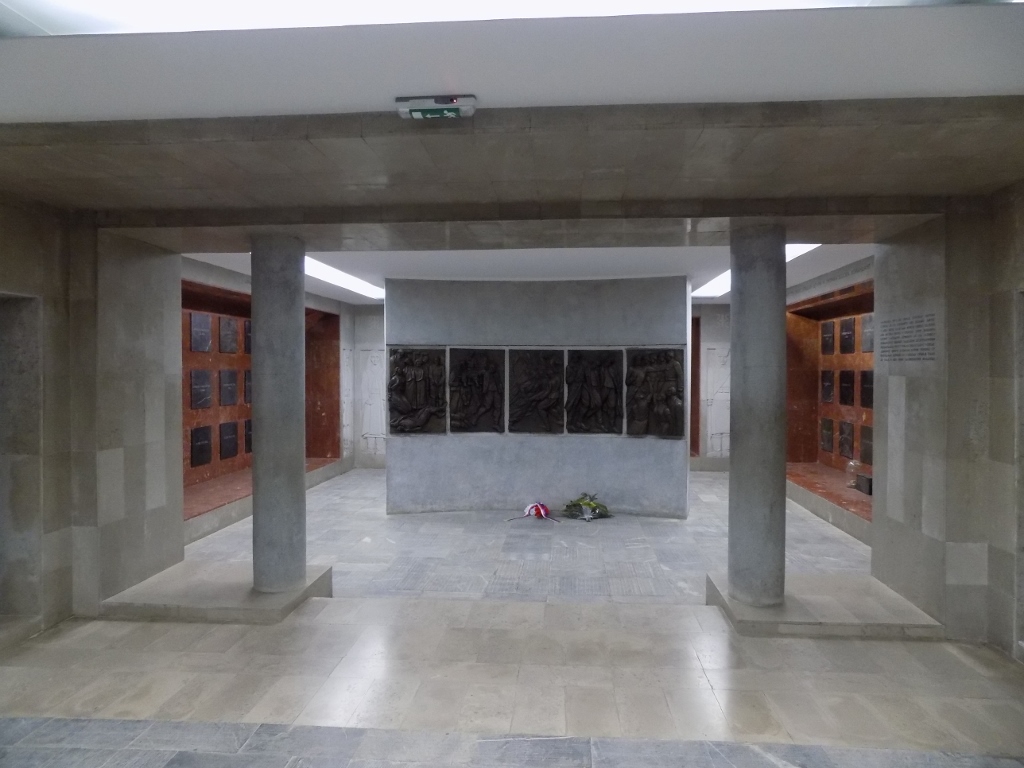 Church of St Demetrios, the crypt
Church of St Demetrios, the crypt
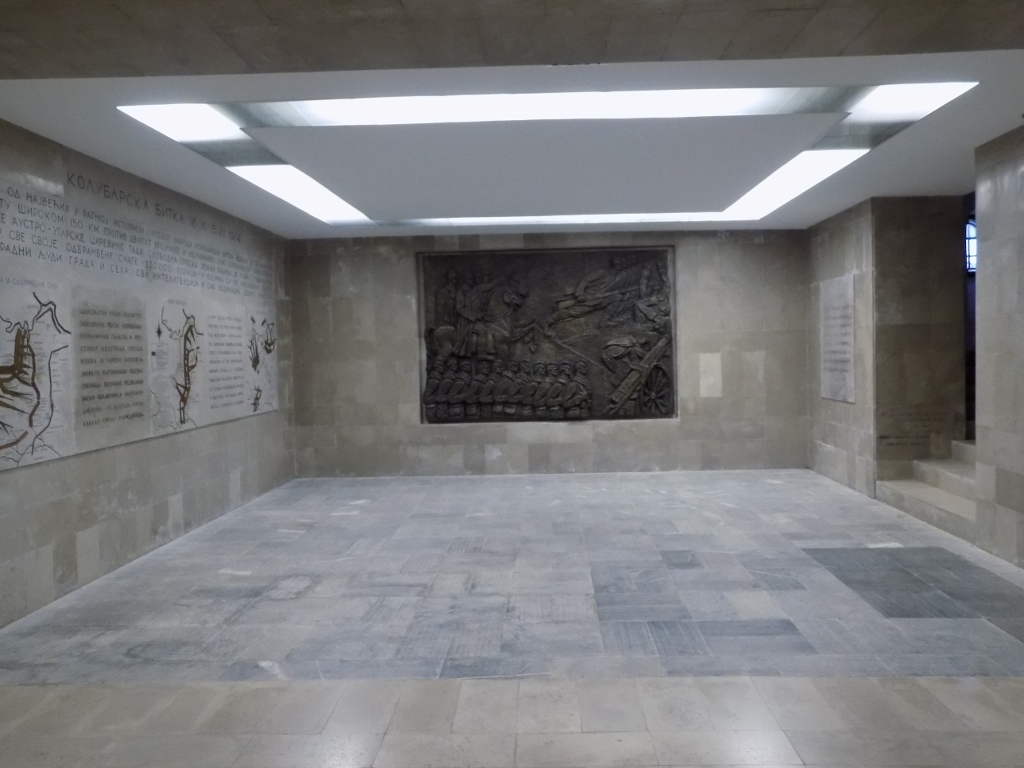 Church of St Demetrios, the crypt
Church of St Demetrios, the crypt
The crypt is very simple and together with the church it is a cultural monument of exceptional importance. We slowly went around and then we returned to the car since we still had to reach village Vranić.
Village Vranić belongs to Barajevo municipality, i.e., it is located on the territory of the city of Belgrade at some 30 km from the downtown area. What I want to say is that it is not far away at all. One needs to follow the Ibarska magistrala road. At some point there is a nicely marked turning towards Vranić and the church we wanted to see is at some 2.5 km away from that turning point.
In the churchyard there are in fact two churches, Church of the Holy Forty Martyrs and the Church of St. Elijah, but we were more interested in the former since it is a wooden church that is a cultural monument of great importance. This church was built in 1823 after the Ottomans burned to the ground the original wooden church. At the beginning of the 20th century, the church was reconstructed and among other things its roof was changed, but in the 21st century there was a new reconstruction and the original appearance of its roof was returned. I found this roof particularly interesting since it is made of wood shingles and thus it is much more attractive and more beautiful than any contemporary roof.
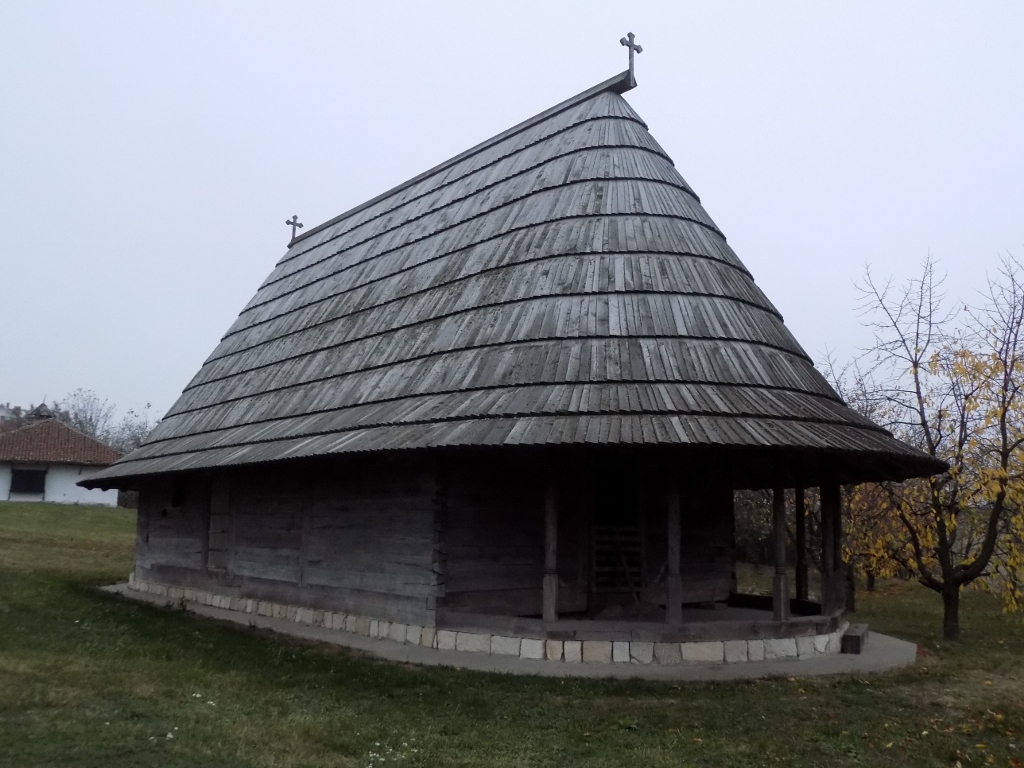 Church of the Holy Forty Martyrs
Church of the Holy Forty Martyrs
In November 2019, the interior of the church was completely closed since there were obviously works being conducted in the interior of the church as well, but with the use of lights on our devices we managed to peer through the dense net. We could see the narthex separated from the naos by arches.
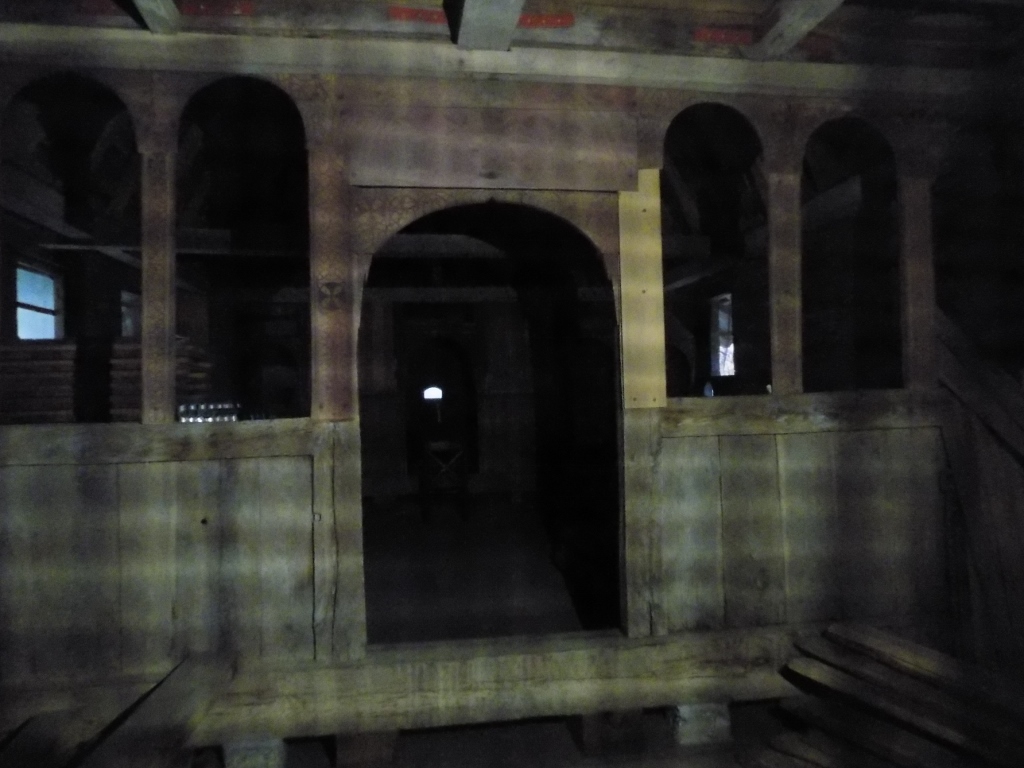 Church of the Holy Forty Martyrs, the interior
Church of the Holy Forty Martyrs, the interior
In the churchyard there are also several other buildings that belong to vernacular architecture, so we walked to them as well. I found the House of the family Matić from Vranić particularly beautiful. It displays a small board saying that this is a house from the 18th century and that it was a gift from Stamenija Matić from Vranić. Here, too, we peered through a window and we could see there was some old furniture inside and it is probably possible to visit the house when one comes during daytime, but on this occasion everything was closed and there were only the three of us in the churchyard.
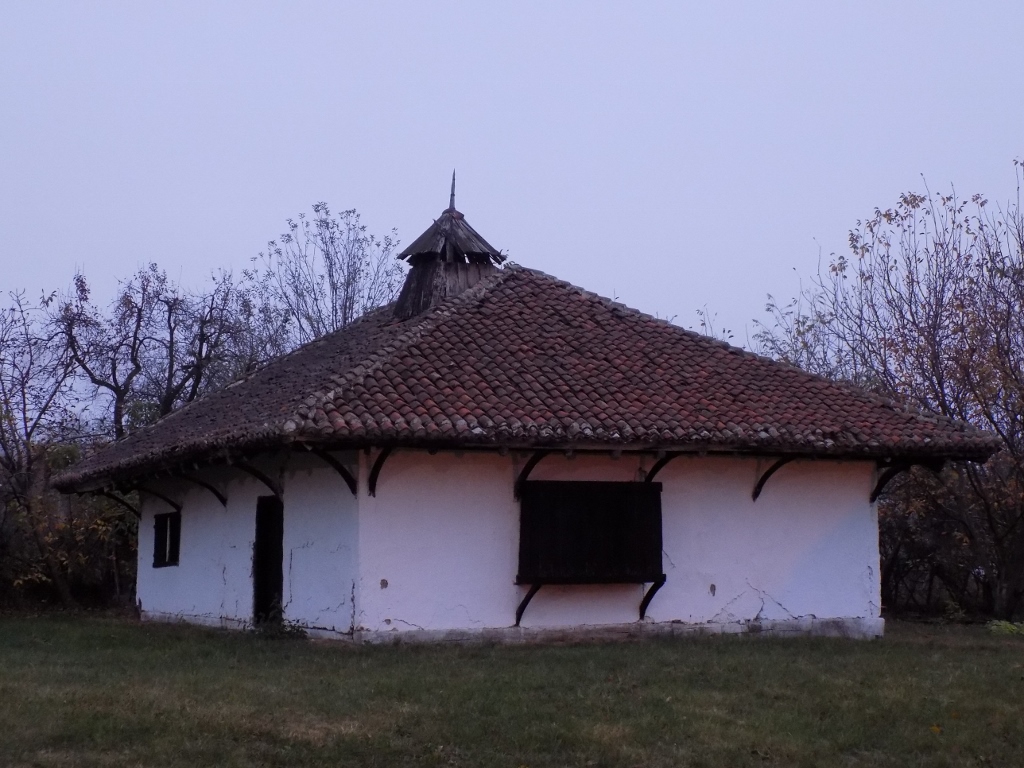 House of the Matić family (note the chimney)
House of the Matić family (note the chimney)
In addition to the fact that I loved the appearance of this house, I was particularly glad that it has been preserved and that it must have been transferred here from somewhere, rather than being left there to go into ruins or to be demolished in order to build something new made of concrete and other contemporary materials. When I went to Lund, Sweden, in June of this year, I was delighted by the open-air museum “Kulturen” where they transfer and keep buildings that would otherwise be demolished (https://www.svudapodji.com/en/sweden-3/).
Be as it may, by the time we made a circle around the House of the Matić family and returned to the church, the lights were already on. Although this short day did jeopardize our sightseeing, it was nice seeing the church as the night started to fall.
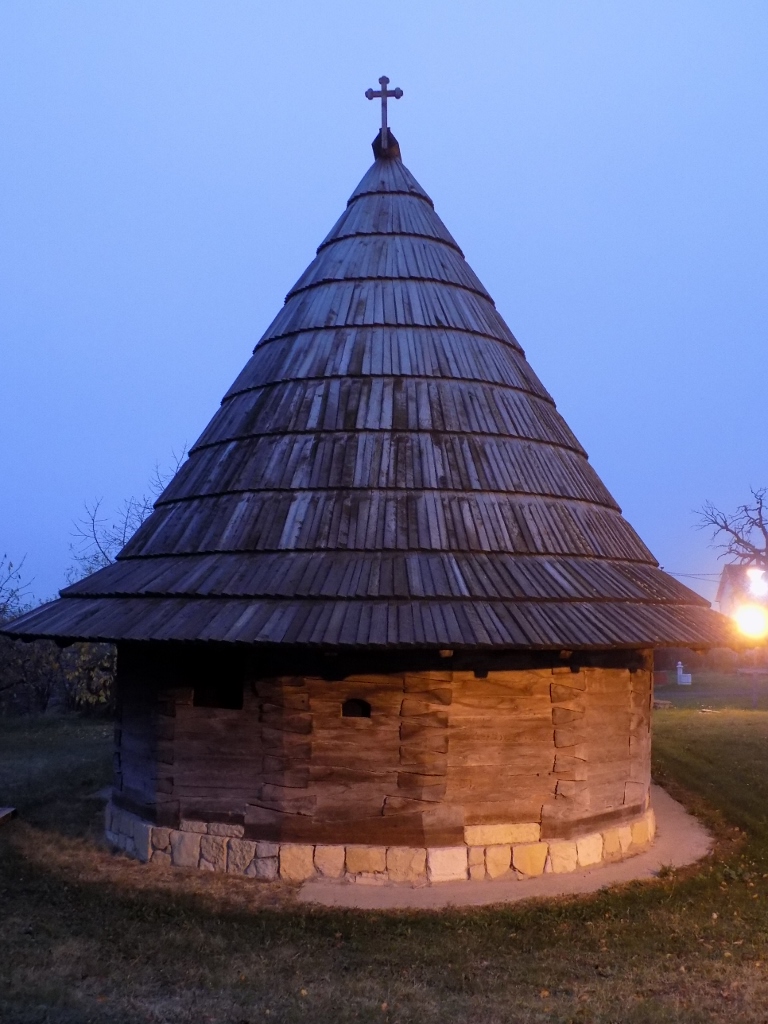 Church of the Holy Forty Martyrs, the outside part of the apse
Church of the Holy Forty Martyrs, the outside part of the apse
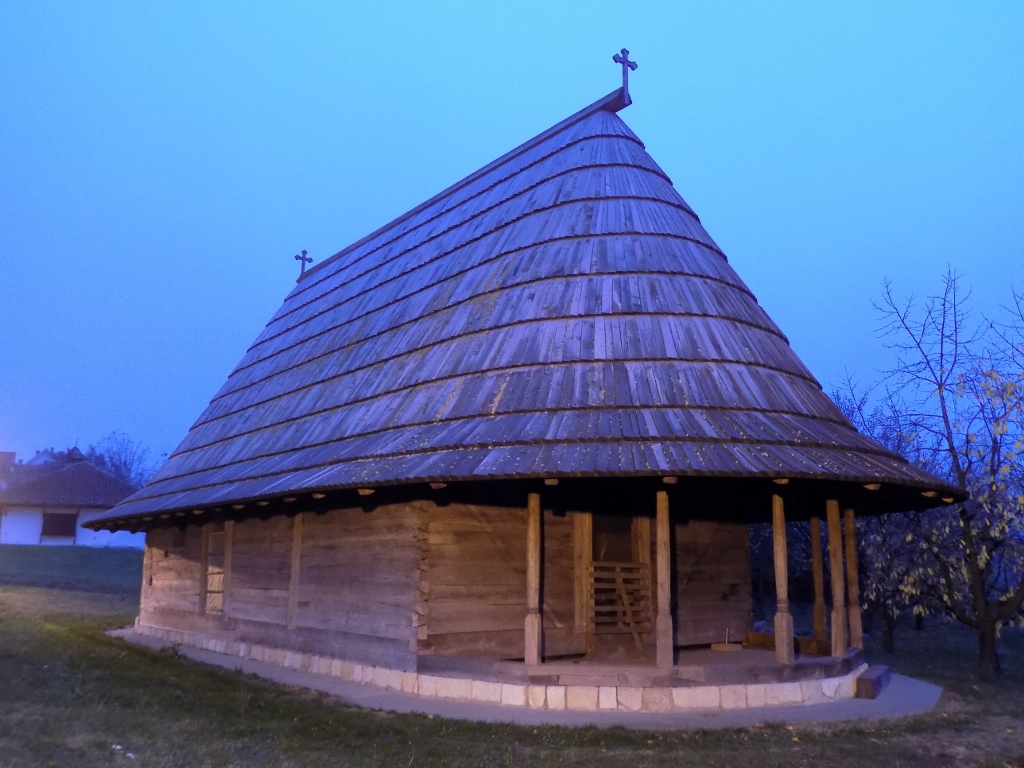 Church of the Holy Forty Martyrs; on the left-hand side, behind it, there is the House of the Matić family
Church of the Holy Forty Martyrs; on the left-hand side, behind it, there is the House of the Matić family
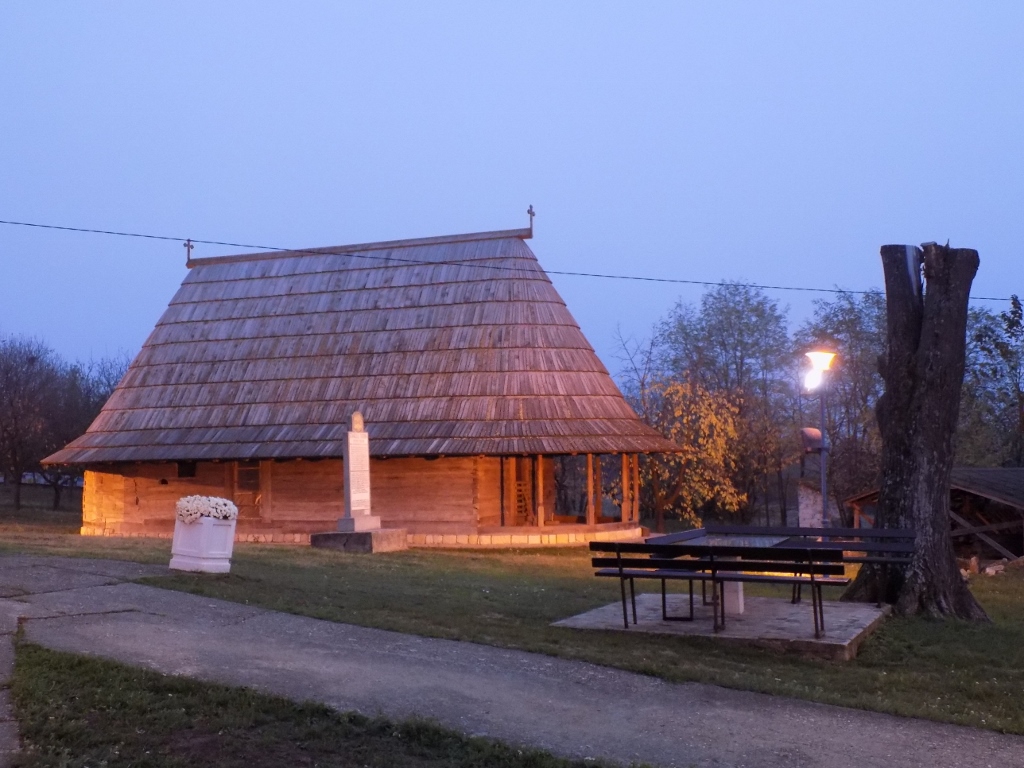 Church of the Holy Forty Martyrs and a section of the churchyard
Church of the Holy Forty Martyrs and a section of the churchyard
The newer church found in the churchyard, the Church of St. Elijah, built at the end of the 19th century is also interesting. There is a very rich collection of icons and other liturgical objects, as well as church furniture from the 18th century. Still, we saw none of that, since something needs to be left for the next time as well.
Thus, we simply returned to the Ibarska magistrala road and soon we were all at our respective homes.